Energy For Rural Development
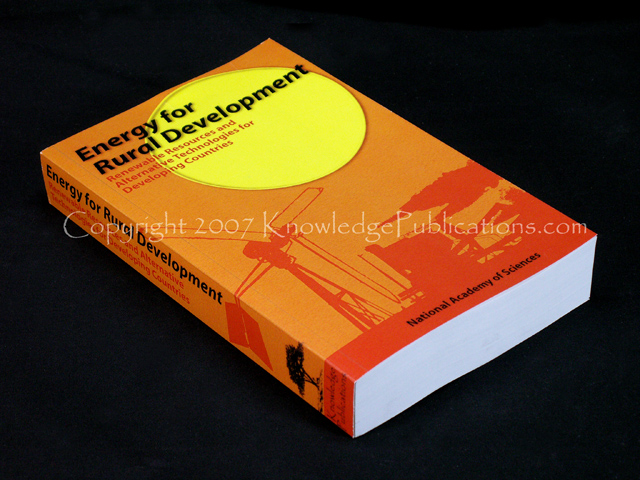
Energy For Rural Development $29.95
ENERGY FOR RURAL DEVELOPMENT: Renewable Resources and Alternative Technologies for Developing Countries focuses on small-scale energy technologies, not based on conventional fuels, that are candidates for rural and village use in developing countries. It also examines the ways in which their candidacy may be affected by technological and economic constraints, present and future. The technologies that this book presents are capable of improving the quality of rural and village life in situations where conventional fuels and power systems have not yet penetrated or are too expensive to become a significant factor in the foreseeable future. This book will provide you with a summary of the state of the art technologies frequently suggested as solutions to rural or individual-family energy needs. This book is great for evaluating the potential of each energy source in each candidate situation.
PLUS – in order to get you even more information, in this book we have included the supplement to ENERGY FOR RURAL DEVELOPMENT: Renewable Resources and Alternative Technologies for Developing Countries –which covers small, low-cost, locally operated energy systems!
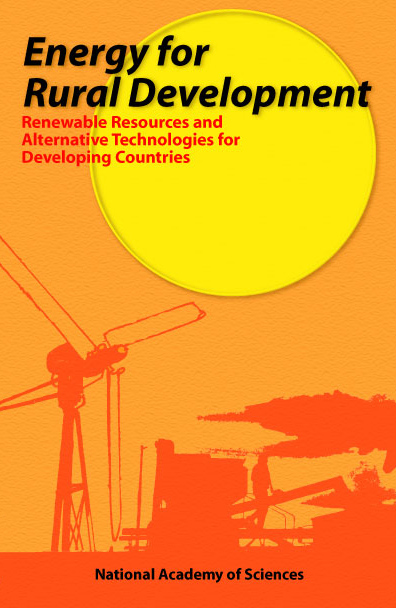
Energy for Rural Development:
Renewable Resources and Alternative Technologies for Developing Countries with Supplement
Some of the most promising energy technologies discussed in this book involve conversion of the energy in wind and water to electricity, and the use of solar energy for heating and perhaps cooling. ENERGY FOR RURAL DEVELOPMENT reminds the reader that unless a technological development improves agricultural productivity, moves cash, crops to market more efficiently, or brings in manufactured consumer goods at lower costs, it is not likely to have a significant effect on the economic growth potential of a rural economy
There are applications of technologies that can indeed contribute to overall economic growth. Improved communication, for instance, stemming from the availability of increased amounts of cheaper electricity, can make possible the dissemination of vital information on agricultural problems, public health, nutrition, and family planning. Solar crop driers can play a significant role in improvement of crop storage, increasing both the quantity and quality of the usable crop at the end of the storage period. Another example involves the widespread use of solar heating as opposed to the use of dung as fuel to replace the declining supply of firewood in many developing countries which seriously affects agricultural productivity by eliminating its use as fertilizer (An approach to this problem—providing a fuel while preserving the fertilizer potential of dung—is the subject of the Biogas book series…). An array of such small improvements, by relieving pressures on other energy sources that directly influence productivity, will have a long-term cumulative effect on a national economy and should not be discounted.
The energy technologies discussed in the original volume and the supplement are based on well-established scientific principles, seem the most susceptible to significant improvement through purely technological innovations, and are therefore, highly promising possibilities for the developing countries.
RENEWABLE RESOURCES AND ALTERNATIVE TECHNOLOGIES FOR DEVELOPING COUNTRIES
INTRODUCTION
Energy Technology and Economic Development—An Overview
Conclusions and Proposals
NONTECHNICAL SECTION
PART I DIRECT USES OF SOLAR ENERGY
Heating, Cooling, Distillation, Crop Drying, and Power Generation
Photo-voltaic Devices
PART II INDIRECT USES OF SOLAR ENERGY
Wind Energy
Hydropower
Photosynthesis as an Energy Source
Microbiological Conversion of Plant Materials to Liquid Fuels
PART III OTHER TECHNOLOGIES
Geothermal Energy
Energy Storage
TECHNICAL SECTION
PART I DIRECT USES OF SOLAR ENERGY
Heating, Cooling, Distillation, Crop Drying, and Power Generation
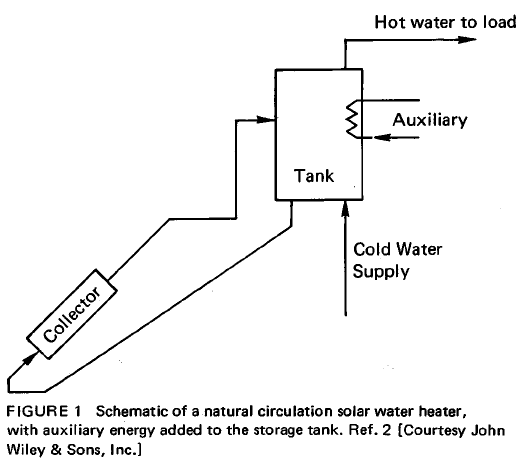 |
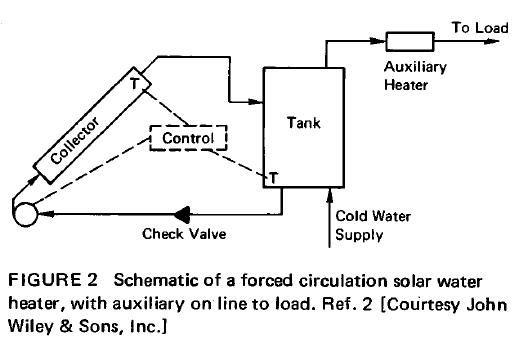 |
SOLAR WATER HEATERS
Solar water heaters constitute a fairly recent development based on a common natural phenomenon: cold water in a container exposed to the sun undergoes a rise in temperature. In its modern form, the solar water heater is basically a flat-plate collector and an insulated storage tank. The collector is commonly a blackened metal plate with attached metal tubing and is usually provided with a glass cover and a layer of insulation beneath the plate. The collector tubing is connected by piping to a tank that stores hot water for use during non-sunny periods. When mounted on a roof or other suitable support, the collector absorbs solar radiation; by transfer of the resulting heat to water circulating through the tubing, hot water is supplied to the storage tank. In the most common designs, the storage tank is located above the top of the collector. The elevated position of the tank results in natural convection: water circulates from the collector to the tank and no pump is required. A typical arrangement is illustrated in Figure 1. Figure 2 shows how the system is modified when natural convection circulation ("thermosiphon") is not available. A solar collector area of 30-40 ft2 (3-4 m2) in combination with an insulated tank of 50-100 gal (200-400 1) capacity can provide 50-80 gal (200-300 1) of hot water at about 140°F (60°C) per average sunny day in a favorable climate.
Photovoltaic Devices
 |
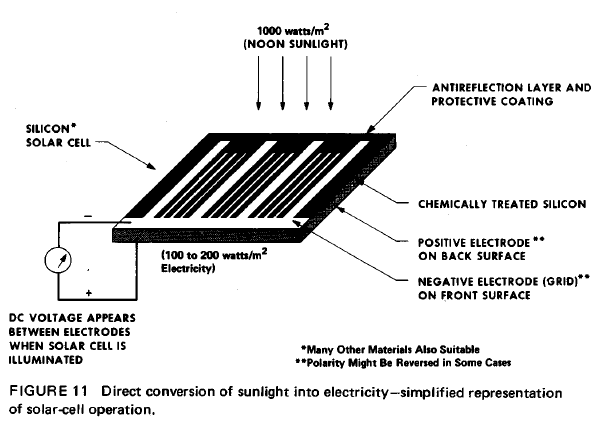 |
The extraordinary simplicity of a solar-photovoltaic system (Figures 10 and 11) would make it appear a highly desirable energy system for terrestrial purposes, both in industrialized and developing nations. The attractive attributes of photovoltaic arrays include the absence of moving parts, very slow degradation of properly sealed cells, possibility for modular systems at sizes from a few watts to megawatts, and extreme simplicity of use. The exceedingly high costs of development and fabrication of spacecraft solar arrays, however, have discouraged any serious thought of widespread terrestrial use of such a technology at the present time, in spite of the potentially attractive characteristics of such systems. A complete spacecraft solar-cell array costs anywhere from $500,000/kWe (average) for the Skylab arrays (10 kWe) to several million dollars per average kilowatt for early Mariner spacecraft arrays. An example of such an array is illustrated in Figure 12, where a Mariner IX spacecraft is shown with four large panels designed to deliver 400 W (total) of DC electrical power with an incident solar illumination of 690 W/m2 (Mars orbit).
PART II INDIRECT USES OF SOLAR ENERGY
Wind Energy
Hydropower
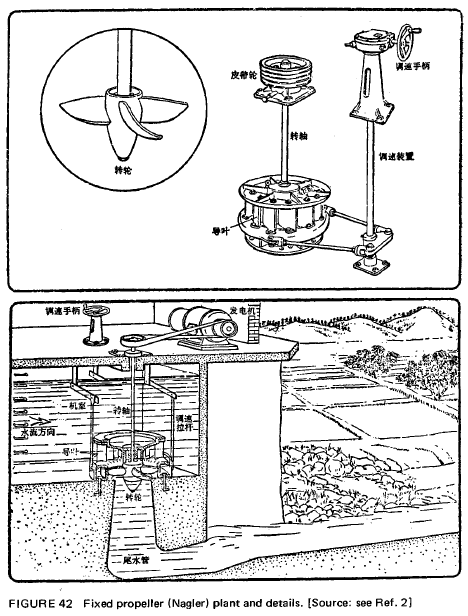 |
The Nagler fixed-blade propeller turbine is a full-admission reaction turbine with a direction of flow described as "axial," that is, parallel to the axis of rotation (Figure 42). It resembles a ship's propeller and indeed may be considered as the inversion of it; its rotor is therefore a much simpler structure than that of the Francis turbine. The low-head, high-speed characteristics of the Nagler turbine often make it possible to connect it directly to electrical generators. The Russian and American hydroelectric units mentioned later as available for developing countries use propeller turbines directly connected to electric generators. |
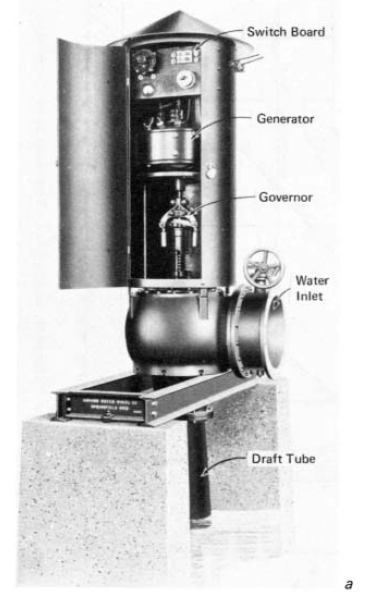 |
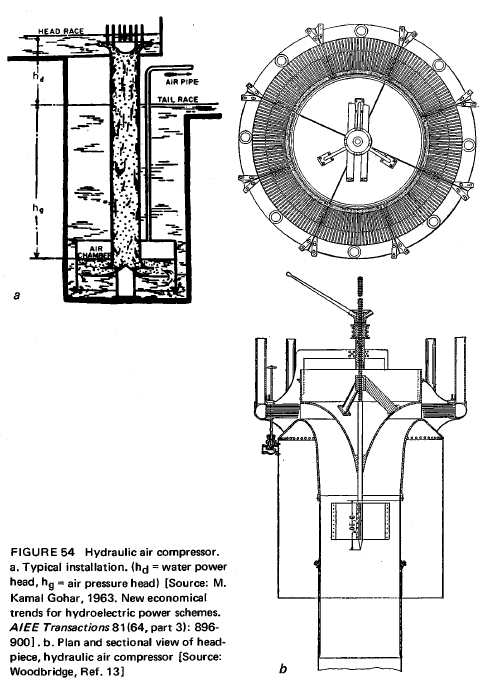
Basically, the hydraulic air compressor is the inversion of the air-lift pump. It is a simple device in which water at some elevation is allowed to flow into a vertical pipe through a circumferential Venturi (convergent-divergent) entrance. At the minimum areas of the Venturi section, openings are provided so that the water flowing past these openings will induce air to be sucked into them and become entrained in the water stream (Figure 54). If the water velocity is high enough, the entrained air will be carried to the bottom of the pipe and into a chamber where the air is trapped and compressed by the conversion of its kinetic energy to potential energy.
Photosynthesis
Microbiological Conversion of Plant Materials to Liquid Fuels
PART III OTHER TECHNOLOGIES
Geothermal Energy
Energy Storage
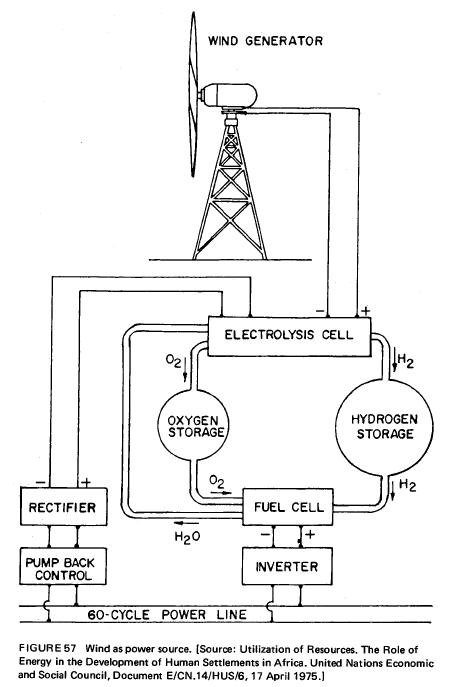
One interesting facet of electrolysis is that it can be performed with very high efficiency at very high pressures, provided the temperature is elevated to about 200°C. Efficiencies of 92-93 percent can be achieved at pressures of 150-250 atmospheres at these temperatures. These pressures can be created by the gas generated, if the system is properly designed, and this would eliminate the need for compressor pumps. Generally, the elevated temperatures can be achieved by insulating the pressure vessels and using the internal (I2 R) losses to supply the necessary heat. Thus, the whole electrolysis system is essentially a static (no moving parts) system with the exception of manual valves. The input energy must be electricity, which for the time being could be obtained from wind-generation systems (Figure 57).
APPENDIXES
1. Energy Research and Development with Potential for Small-Scale Application
2. Manufacturers of Solar Heating and Cooling Devices
3. Manufacturers of Terrestrial Solar Photovoltaic Devices
4. External Combustion Engines—Rankine and Stirling Engines as Small-Scale Power Sources for Developing Countries
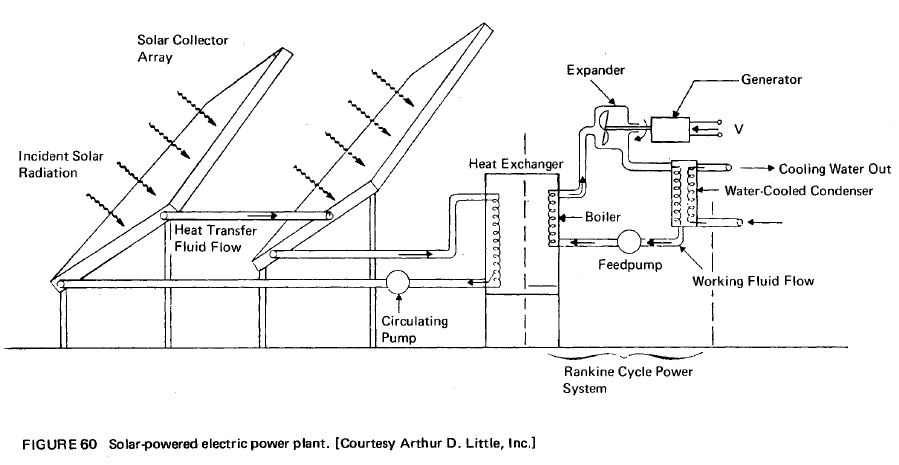
Figure 60 shows a schematic of a solar-powered organic Rankine-cycle engine loop. The system of the schematic indicates the engine driving an electric generator. However, the engine could just as well be driving a water pump or the compressor of a cooling system.
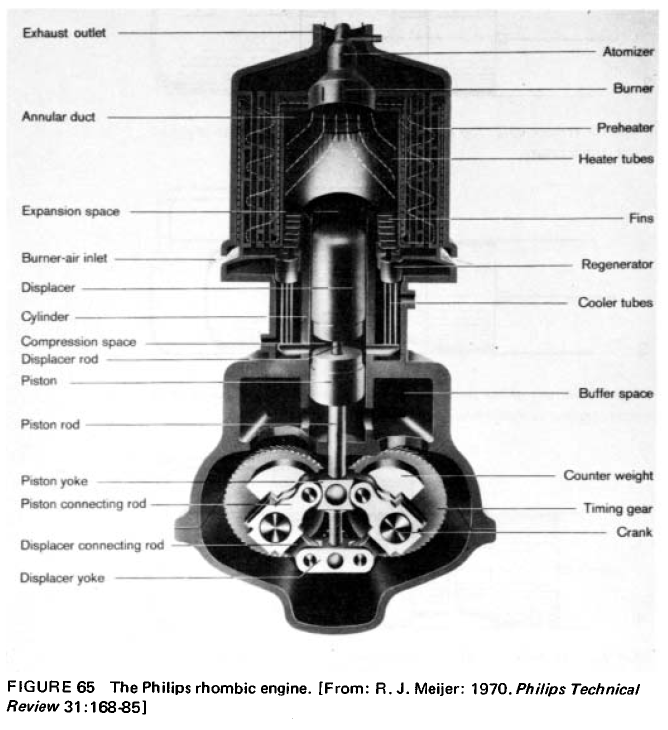
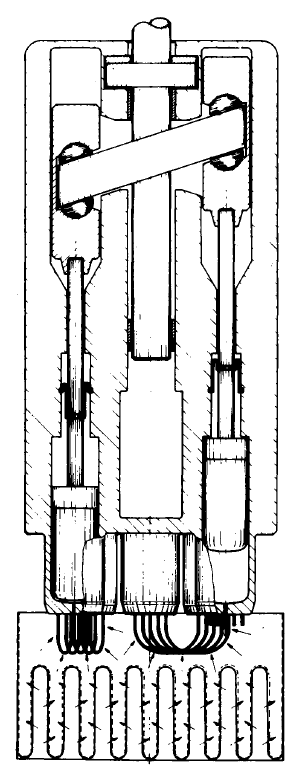
Toward the end of the Second World War there was launched an intensive development effort that has resulted in today's powerful, efficient, and quiet Stirling engines (Figures 65 and 66) intended for automotive use
5. Currently Manufactured Windmill Pumps and Generators
6. Commercial Developers of Wind Machines
7. Windmill Towers for Construction on the Farm
8. Currently Manufactured Small-Scale Hydropower Machinery
4. The Helical Rotary Screw Expander and Its Potential for Geothermal Application
SUPPLEMENT
INTRODUCTION
PART 1: DIRECT USES OF SOLAR ENERGY
Photovoltaics
Sun/Earth-Tempered Building Designs
PART 2: INDIRECT USES OF SOLAR ENERGY
Wind Energy
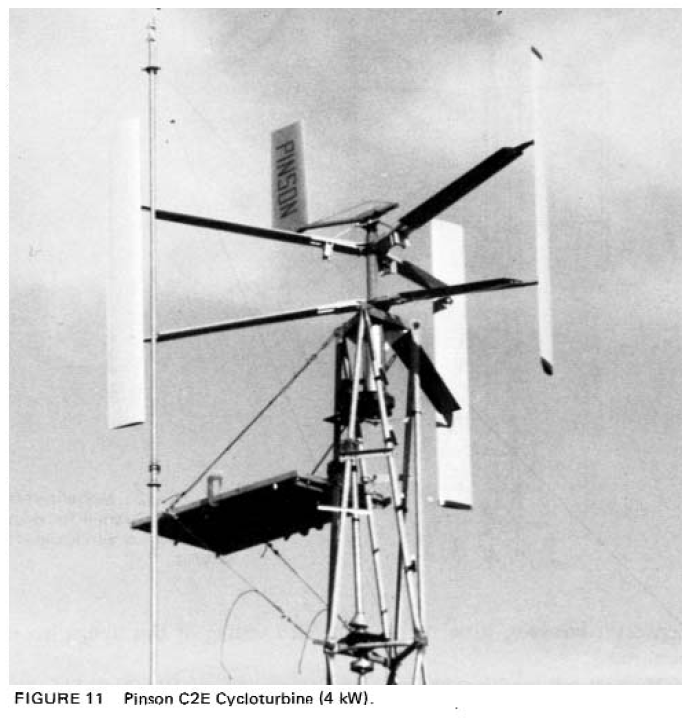
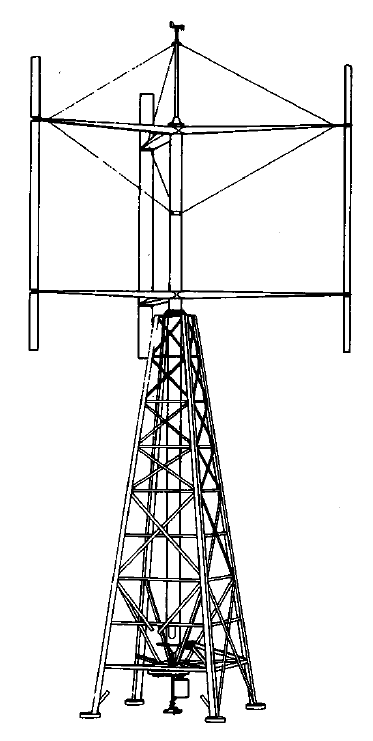
Several U.S. companies (e.g., Pinson Energy Corporation and McDonnell Douglas Corporation) have developed vertical-axis "cyclogiros," which overcome the performance losses of the Darrieus by using blade pitch regimens that are scheduled throughout each rotor revolution (Figures 11 and 12). However, the increased performance of these machines over the Darrieus is somewhat offset by the complexity of their mechanical and electrical control systems.
Energy from Falling Water
Small-Scale Hydroelectric Systems
Hydraulic Air Compression
Energy from Biomass
Introduction
Anaerobic Digestion
Energy Farms Utilizing Aquatic Plants and Wastewater
Ethanol (Alcohol) Production

A new approach to anaerobic digestion is currently under development by NASA's National Space Technology Laboratories, incorporating an "anaerobic filter" into the digestion system (Wolverton and McDonald 1979b). As depicted in Figure 42, the first chamber holds all the pulp and plant juice. The anaerobic filter in this case consists of small rocks (pea gravel) which provide a large surface area for bacterial growth. The plant juice is periodically circulated through the anaerobic filter and exposed to a mixed culture of the acid-forming and methanogenic bacteria. Preliminary results with this technique indicate that complete digestion of fresh plant material such as water hyacinth, duckweed, and kudzu (Pueraria lobata, a prolific terrestrial plant) can be accomplished in an average of 23 days with no loss in total methane production over the old batch or continuous-feed methods.
Thermochemical Conversion of Biomass
PART 3: OTHER TECHNOLOGIES
Geothermal Energy
Energy Storage
Storage Batteries
Flywheel Energy Storage Systems
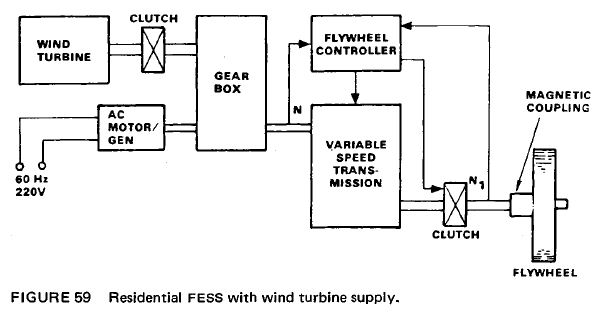 |
 |
Residential Flywheel with Wind Turbine Supply. Flywheels can be used to store excess wind energy for a windless day. In late 1978, the Garrett Corporation (USA) was commissioned by the U.S. Department of Energy to develop an engineering design for a mini-residential FESS rated at 5-kW electric output. Then-current low technology was utilized in this design which was completed in late 1979.
After evaluating five candidate systems, the design shown in Figures 59 and 60 was selected for further refinement. Considering cost and safety, the E-glass/epoxy, rim-shaped rotor was selected. The flywheel is housed in a metal container evacuated to less than 10 aµ.
Pedal Power
Stirling Engines
Solid-State Electric Inverters
APPENDIXES
A Manufacturers of Energy-Related Devices
B Centers of Research and Development
C Suggested Reading
INDEX

Energy For Rural Development $29.95
ENERGY FOR RURAL DEVELOPMENT: Renewable Resources and Alternative Technologies for Developing Countries focuses on small-scale energy technologies, not based on conventional fuels, that are candidates for rural and village use in developing countries. It also examines the ways in which their candidacy may be affected by technological and economic constraints, present and future. The technologies that this book presents are capable of improving the quality of rural and village life in situations where conventional fuels and power systems have not yet penetrated or are too expensive to become a significant factor in the foreseeable future. This book will provide you with a summary of the state of the art technologies frequently suggested as solutions to rural or individual-family energy needs. This book is great for evaluating the potential of each energy source in each candidate situation.
PLUS – in order to get you even more information, in this book we have included the supplement to ENERGY FOR RURAL DEVELOPMENT: Renewable Resources and Alternative Technologies for Developing Countries –which covers small, low-cost, locally operated energy systems!

